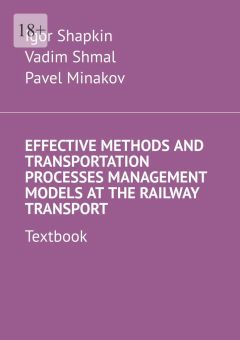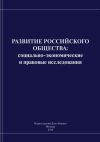Текст книги "Effective Methods and Transportation Processes Management Models at the Railway Transport. Textbook"

Автор книги: Igor Shapkin
Жанр: Прочая образовательная литература, Наука и Образование
Возрастные ограничения: +18
сообщить о неприемлемом содержимом
Текущая страница: 5 (всего у книги 11 страниц)
3 TRAFFIC FLOW MANAGEMENT MODERN MODELS
3.1 Car fleet management model in multiple operators conditions
The modern model of the freight transportation market requires the development of new approaches to the management system of the car fleet of different owners. One of the main reserves for improving the efficiency of the functioning of Russian railway transport is the improvement of the technology of work and, first of all, related to the management of the car fleet.
The main management processes in railway transport include operations with freight cars related to loading, sorting and forming, moving, unloading and regulating their progress in an empty state. In connection with the privatization of the car fleet, increasing the efficiency of the technology of working with a fleet of freight cars in the conditions of a plurality of operators makes it necessary in order to increase the level of customer orientation and competitiveness of railways. The modern adoption of effective regulatory measures for the relocation and rational use of the car fleet on the basis of theoretical provisions will significantly reduce the costs of the industry and contributes to improving the quality of operational work in a market economy.
Until recently, the regulation of wagon fleets was carried out in the process of fulfilling technical standards and consisted in replenishing (withdrawing surpluses) of the fleet of wagons of stations, railways in order to form sufficient loading resources to fulfill shippers’ requests for transportation.
This is achieved through the following control actions by employees of the Central Directorate of Traffic Management of Russian Railways and regional directorates:
– redistribution of tasks for unloading and delivery of empty wagons between roads; loading in accordance with the actual location of the car fleet;
– establishment of adjustment gaps between loading and unloading, taking into account the types of wagons necessary to meet the clientele’s requests for transportation;
– ensuring loading at the expense of wagons released from unloading and coming for adjustment based on the application of methods of optimal resource management;
– establishment of additional tasks for the transfer of loaded or empty wagons; use of the reserve of Russian Railways;
– concentration of loading or its temporary reduction with the replenishment of underload in the following days;
– restriction or prohibition of loading caused by extraordinary circumstances.
The tasks of managing the car fleet were mainly solved using linear programming methods.
When drawing up schemes for the movement of unladen rolling stock, the results obtained in the framework of solving the transport problem of linear programming have long been used. The current state of the problems of regulating empty car traffic was accompanied by detailed mathematical algorithms, such as:
– on providing a certain loading region with an additional number of rolling stock by a given date (not provided for by the technical plan);
– on the movement of empty wagons from the place of unloading to the place of new loading, subject to their minimum total mileage;
– on the most rational way to relocate the surplus fleet of empty wagons to the loading roads;
– on the daily planning of the regulation of empty wagons.
All these problems were mathematically formulated as transport problems, or as linear programming problems, or as network problems. An example of solving transport problems, including those related to the regulation of car traffic, is the task of optimally dividing the Russian Railways network into a certain number of management regions so that the value of the quota of the car fleet for the regions is optimal. An important point in their study is the consideration of the time factor, when the transport problem from stationary (without taking into account the time of formation and consumption of resources) turns into a dynamic one (taking into account the time of formation and consumption of resources).
The task of managing the loading of wagons was formulated as the task of dynamically optimizing the provision of loading by empty wagons. However, it was solved without taking into account the multiplicity of freight car operators and did not give the required solutions. Therefore, there is a need and there are very real possible solutions to the problem of managing empty car traffic at the modern level within the framework of information technology, taking into account the multiplicity of operators, calculating the economic feasibility of using cars and improving the quality of operational work.
The problem of efficient use of freight cars in the conditions of a plurality of operators has become one of the main ones in the operational activities of the Russian railways.
To solve this problem, it is necessary to use modern economic and mathematical methods, modeling technological processes, developing effective adequate models of information and management systems that ensure timely decision-making.
One of the tasks is to optimize the movement of rolling stock units. The statement of the problem is as follows.
Let there be m points of departure defined by the codes of the Unified Network Markup (UNM) ESRA1, ESRA2,…,ESRAm, in which the surplus of units of railway rolling stock (hereinafter referred to as mobile units) ai, i = 1.2 …, m (stocks) transmitted (moved) in the process of satisfying consumer requests from departure stations to n destinations is predicted.
4 OPTIMIZATION MODELS AND DECISION-MAKING METHODS FOR RAIL TRANSPORT MANAGEMENT
4.1 Optimization basic principles
Optimization is a purposeful activity that consists in obtaining the best results under the right conditions. The formulation of the optimization problem presupposes the presence of an optimization object, which must have certain degrees of freedom – control actions that allow you to change its state in accordance with certain requirements. The solution of any optimization problem begins with the identification of the optimization goal, i.e. the formulation of the requirements for the optimization object. The possibility of successfully solving the problem may depend on how correctly these requirements are expressed. In addition, another condition for the correct formulation of the optimization problem is the availability of a quantitative assessment of the quality of the optimization object of interest. This condition is also necessary, since only when it is fulfilled, it is possible to compare the effects of the choice of certain control actions. Quantitative assessment of the optimized quality of an object is usually called an optimality criterion or an objective function (quality function, economic criterion, etc.). The type of optimality criterion is determined by the specific content of the optimization problem to be solved and can sometimes have a significant impact on the choice of the solution method. Ultimately, the achieved value of the optimality criterion quantifies the effect of optimization. Thus, the process of solving problems related to the optimization of complex systems, which is the transportation process in railway transport, can be divided into 3 stages:
1. Study of the problem and its meaningful description (statement of the problem);
2. Selection of a mathematical method and model for solving the problem and the objective function with constraints;
3. Solution of the obtained mathematical problem using the selected solution model;
Speaking about the systematic approach in relation to railway transport, it should be borne in mind that this method proceeds from the fact that the transport network and its objects are a complex structural formation, or rather an organized set of elements (complex system). A systematic approach to the calculation of railway systems makes it possible to see more clearly alternative solutions and ways to improve the efficiency of the development of the railway transport network. This is the main content of complexity and its main methodological value. It follows from this that railway complexes should be considered as part of the railway network with the allocation of network-wide tasks, issues of formation and construction (with quantitative and qualitative assessment) of their schemes and technologies.
To study any complex system by mathematical methods (especially with the help of a computer), its mathematical model must first be constructed. In other words, this real (physical, informational) object must be matched with some adequate mathematical object, called its model, the study of which with the help of. Mathematical methods allow you to get useful recommendations regarding the real object in question. Along with this, it should be noted that mathematics gives the researcher only an appropriate abstract structure suitable for creating models of certain real objects, thereby predetermining a high degree of generality from understanding. The type of mathematical model depends not only on the nature of the real object, but also on the problems that it is happy to solve, on the required accuracy of their solution, since any model describes a real object only with some degree of approximation to reality.
When studying the efficiency of technological processes of transport systems, they proceed from the premise that operational processes are probabilistic, correlational (in the sense of the presence of random relationships) in nature, and not uniquely deterministic.
Often, both of these approaches are considered in the form of, for example, weighted averages (train weight, axial load, travel times, intervals, etc.) and operational constants (removal coefficients, accumulation parameter, etc.), the value of which is established on the basis of observations and probabilistic ideas about the processes. However, a transport process involving elements of chance is not a purely random process; The role of the «organized» component is exceptionally high in it – the train schedule, technological processes, technical equipment of transport systems.
The main purpose of system-technical models of transport systems is to obtain the qualitative characteristics of a complex object by quantitative methods and to identify bottlenecks.
A distinctive feature of the modeling procedure is the complete absence of any real interactions between the model and the original. In the process of modeling, only a controlled information connection between the object and the model is established. The available stock of knowledge about the original is transferred to the model, the testing of which, in turn, enriches our knowledge of the aspects of the structure or functions of the object that interest us. The model characterizes the object in some cognitive sense, and not the object as a whole in itself.
Note that the most complete, and in some cases exhaustive, study can be carried out in the event that explicit dependencies are obtained that connect the desired values with the parameters of the system and the initial conditions. However, they can be obtained only for relatively simple systems. If the system under consideration is complex enough, the analytical study encounters significant and often insurmountable difficulties, then, in an effort to obtain an analytical solution, they often go to the deliberate abolition of the original model in order to be able to study some general properties of the system. In some cases, the researcher can be satisfied with the conclusions that can be drawn with qualitative methods of analyzing a mathematical model. To obtain an analytical solution to various types of functional equations, a powerful mathematical apparatus has been developed (algebra, functional analysis, theory and methods for solving various differential, integral and difference equations, the theory of probabilistic processes, etc.).
If the system under study is complex enough, then in order to obtain an analytical solution to the problem, strict restrictions are usually imposed on its model, which leads to its significant simplification. At the same time, it is necessary to neglect some features of the system, which is why the created model already, sparingly speaking, ceases to meet its main purpose – to be a means of studying the complex system under consideration. But, despite this, they often still strive to build such an analytical model that provides, albeit crude, but a simple and easily observable solution to the problem under consideration. It is usually used as an indicative until more accurate solutions are obtained by other methods.
Numerical methods, in comparison with analytical methods, are applicable to a much wider class of functional equations, but obtaining a solution is of a particular nature and it is not always possible to draw general conclusions from them. The use of numerical methods has become especially effective in connection with the introduction of modern computer technology.
Simulation models with the help of a modeling algorithm approximately reproduce the original process itself in terms of its functioning in time, and the elementary phenomena that make up the process are simulated, while maintaining their logical structure and sequence of flow in time.
The essence of the considered modeling method is the implementation of a special algorithm on a computer that reproduces, generally speaking, a formalized process of a complex system. The modeling algorithm allows, based on the initial data containing information about the initial state of the process (input information) and its parameters, to obtain information about the states of the process at arbitrary points in time. The influence of random factors on the course of the process is simulated using random numbers with probabilistic characteristics specified or produced during the modeling process.
Information about the states of the process obtained as a result of the simulation algorithm is properly processed and used to solve practical problems. Note also that interesting information about the process can be obtained by considering individual implementations of the construction of a random process in this way. However, a thorough study of a complex process is associated with the determination of statically stable average characteristics calculated from a large number of implementations.
In connection with the study of the processes of complex systems by computer modeling, the following main problems arise:
1. Construction of a formalized process diagram that is accessible from the point of view of simplicity for modeling on modern computers and provides the necessary accuracy in solving practical problems;
2. Construction of compact and easy-to-use modeling algorithms and their programming;
3. Formulation and development of a methodology for solving the problem of systems research using simulation results;
The main advantage of simulation models, in comparison with analytical ones, is the ability to solve problems of exceptional complexity. When simulating the process of functioning of the system, such features as: the presence of elements of continuous and discrete action are not an obstacle; nonlinear relations of any nature, describing the relationships between the elements of the system; the impact of numerous random factors of a complex nature, which lead to fundamental difficulties in analytical research.
Simulation models are applicable to the study of more complex processes. In addition, there is no need to create special equipment for each new task.
However, along with the noted advantages, simulation modeling, like any numerical method, has the significant drawback that the resulting solution is always numerical, responding to fixed values of system parameters, input information and initial conditions. Despite this very serious drawback, simulation modeling is currently the most effective method of studying complex systems, and sometimes the only practically achievable means of obtaining the information we are interested in about the behavior of the system, especially at the stage of its design or modernization.
It has already been noted that an attempt to take into account the influence of random factors in analytical models leads – if the system under study is complex enough – to very significant and not always surmountable difficulties, while the introduction of random perturbations into simulation models does not introduce fundamental complications. For this reason, probabilistic analytical models are used to study relatively simple systems, and the study of complex random processes is carried out, as a rule, on simulation models. Since the results obtained during reproduction on the simulation model of the process under consideration are implementations of random objects (quantities, functions), in order to find objective and stable characteristics of the process, its repeated reproduction is required, followed by statistical processing of the data obtained. That is why the study of complex systems using simulation models is called statistical modeling.
With the help of statistical modeling, it is possible to calculate the value of any functional given on a set of implementations of the process of functioning of the model under study. The most important is the indicator of the effectiveness of the system, with the help of which they solve the problems of assessing the effectiveness of various management principles; evaluation of variants of the structure of a complex system; assessment of the impact of changes in various parameters of a complex system or its individual elements, as well as initial conditions.
These are the tasks of the so-called analysis of complex systems.
No less important, but much more difficult are the tasks of synthesizing complex systems, when it is required to create a system with predetermined properties and, in a sense, minimal. The results of modeling are often useful in the synthesis of the system to assess the quality of certain of its variants.
Thus, to solve practical problems, both analytical methods and modeling of complex computer systems are widely used.
Usually, the research method is chosen after the mathematical model of the real object has already been built. In general, when constructing mathematical models for complex systems, both analytical and algorithmic descriptions of the processes of functioning of their elements are used. To simplify the formalization of systems, they usually resort to typical mathematical schemes, such as a differential equation, Boolean functions, random processes (for example, in the form of a queuing system), etc., with the help of which it is convenient to describe the elementary subprocesses of the real process of functioning of a complex system.
Depending on the type of model, different solution methods are used. Thus, mathematical programming methods are used to solve problems where it is required to find a vector that delivers the extremum of an objective function under certain constraints. In such problems, the executive vector does not depend on the time factor. If you want to find a function (or vector function) that depends on a certain variable and delivers an extremum to the functional, then this is the problem of the calculus of variations.
In the calculus of variations, they try to obtain equations for finding extremals, i.e. admissible curves on which the functional reaches the extremum.
In many transport problems, the question arises of attributing the most economical program of the model, i.e. finding the optimal values of the parameters of its control. Usually, such problems are solved using the maximum principle developed by Academician L.S. Pontryagin and his students – V.G. Boltyansky, R.V. Gamkrelidze and E.F. Mishchenko.
Dynamic optimization models are widely used in the problems of complex amplification of line throughput. The principle of optimality underlying dynamic programming can often be implemented in the form of a functional equation, the solution of which is more accessible by the method of modern mathematics (including computational mathematics) than the solution of the corresponding equations by the methods of classical mathematics.
The essence of dynamic programming is to study some types of multi-step control processes. The process continues for several stages and consists in the implementation of costs at each stage in such a way as to maximize the function in a finite number of stages.
The solution of the N-step problem can be reduced to the solution of a sequence of tasks: first 1-step, then 2-step, 3-step… and up to the N-step. This is the essence of dynamic programming and Bellman’s principle of optimality. It is defined as follows: optimal behavior has the property that, whatever the initial state and decision at the initial moment, subsequent decisions must constitute optimal behavior relative to the state resulting from the first decision.
Optimal behavior refers to a sequence of decisions in stages that optimizes the function of the parameters of the final state.
Often there are situations when some (or all) parameters of the quality indicator and restrictions may be uncertain and random. In some cases, experience, statistics and the study of the processes that determine the change in the initial data make it possible to establish certain probabilistic characteristics of the parameters of the problem.
The section of linear programming that studies methods for solving problems under conditions of uncertainty is called stochastic programming.
In the formulation of stochastic problems, not only what should be understood as a task plan, but also what should be meant by solving the problem should be stipulated. In this regard, it is of interest to classify stochastic programming problems according to the quality of solving the problem.
It is natural to consider the following indicators of the quality of solving stochastic problems of linear programming: mathematical expectation of the value of the linear form; linear combination of mathematical expectation and variance of linear form; the probability of the linear form exceeding a certain fixed threshold; mathematical expectation of the utility function of a linear form; the maximum of linear form (moreover, the maximum is taken from the set of plans X, and the minimum is taken from the permissible values of a set of random parameters that determine the implementation of random elements of the conditions of the problem), etc. Stochastic programming problems are divided into static and dynamic. In static problems, the stochastic nature of conditions is determined by random variables, in dynamic problems by random functions or random sequences. The regularities of changes in the static characteristics of random sequences are taken into account both in the formulation of the problem and in the construction of analysis methods.
Правообладателям!
Это произведение, предположительно, находится в статусе 'public domain'. Если это не так и размещение материала нарушает чьи-либо права, то сообщите нам об этом.








































